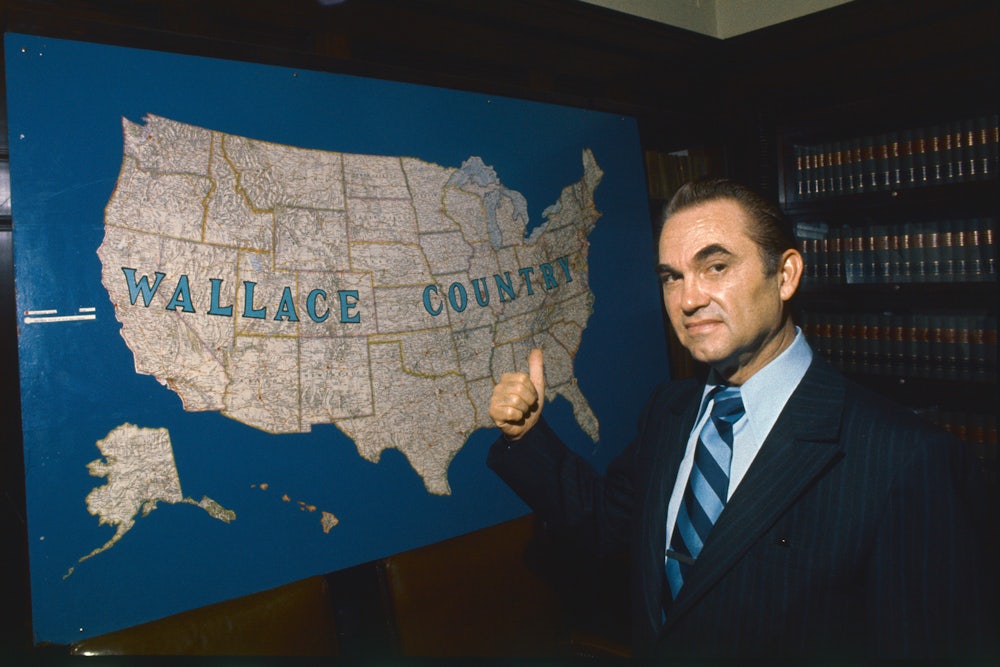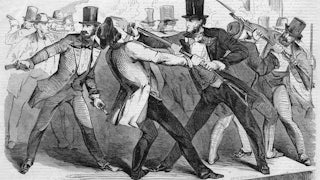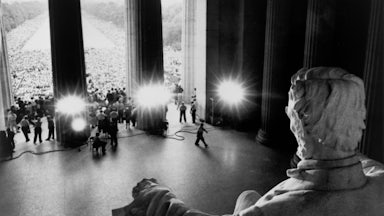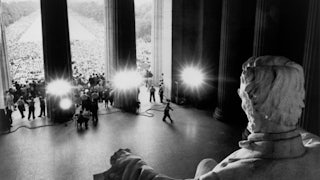On April 23, 1967, George C. Wallace sat for a television interview on NBC’s Meet the Press, ready to reintroduce himself to America. To most Americans outside of the South, Wallace was known as the openly racist, defiantly pro-segregationist governor of Alabama: the one who, four years earlier, bellowed, “Segregation now, segregation tomorrow, segregation forever!” in the face of the swelling civil rights movement; the one who, a year later, stood in front of a University of Alabama building to prevent two Black students from enrolling; and the one who, in 1965, allowed local police to bludgeon civil rights activists marching for the right to vote in Selma. Now planning a presidential run, Wallace knew what the Northern liberal press wanted. To his aides, he privately parodied their caricatures of him: “Hi, y’all. Sho good to see y’all.… I’m jes an ig’rant ol’ hookwormy redneck from Alabama come up to visit yall.”
But instead of the hate-spewing backwoods bigot, viewers got a smooth-tongued politician speaking the language of freedom. When asked if he still supported segregation, he now said he would not “recommend” it, but it was ultimately a decision best left to the states. When journalists depicted him as the embodiment of the racist “backlash” to integration, he replied that there was certainly a backlash, but it was “against big government.” Every time reporters tried to goad him into making a racist remark, he dodged the punch and immediately hit them in the upper lip: Northern cities, he would say, were even more segregated than Southern ones. His message, he told Americans again and again, was not anti-Black at all: It was about freedom from a tyrannous federal government. “When a central government bureaucrat or judge takes from us our right to run our schools, to determine the destiny of our own children, to run our labor unions, our businesses, our hospitals and our very lives,” he said earlier that year, “I do not call that freedom, I call that abject slavery to government.”
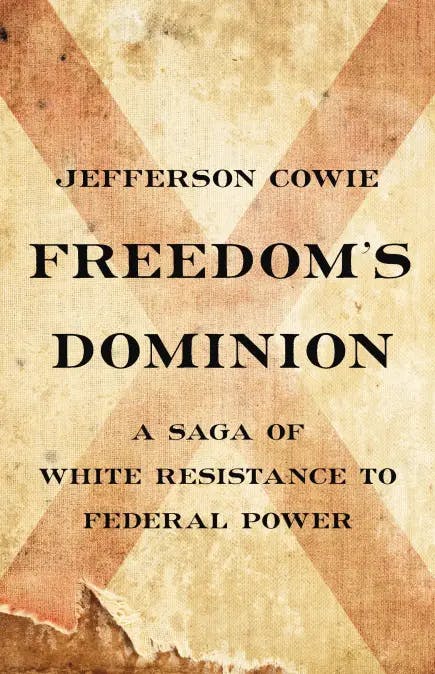
Wallace’s new message resonated with many white Americans outside the South precisely because he did not explicitly endorse racism but cloaked it in the language of freedom against an overbearing federal government. Since the rise of Donald Trump, many journalists have noted the parallels to George Wallace. But where most see George Wallace as injecting something new into modern conservative politics, the historian Jefferson Cowie sees Wallace as tapping into something very old. Since the nation’s founding, he argues in his outstanding and urgent new book, Freedom’s Dominion: A Saga of White Resistance to Federal Power, one common understanding of the term freedom has been the “freedom to dominate others,” especially against a tyrannous federal government.
The idea that freedom has been closely tied to racial domination in American history is hardly new. But Cowie, one of the nation’s leading labor historians, has found a novel way to tell that story. Rather than an intellectual history that charts an abstract idea across space and time, Cowie gives us a visceral, flesh-and-blood narrative rooted in a very specific place: Barbour County, Alabama. Few have probably heard of it, but this rural southeastern county that borders Georgia—population 25,000, largely split between Black and white residents—was not only the birthplace of George Wallace but home to at least six other Alabama governors. Perhaps more importantly, Cowie convincingly argues, Barbour County’s history—from the ethnic cleansing of its Indigenous inhabitants to the enslavement, segregation, lynching, and disenfranchisement of its Black population, to the suppression of its labor unions, all in the name of freedom from federal intervention—encapsulates much of America’s history too.
Cowie divides his narrative into four major episodes, beginning with the forced removal of the Muscogee Nation from Barbour County in the 1830s. The usual villain in this story is Andrew Jackson, who as president oversaw the Indian Removal Act of 1830. The law gave the president the authority to negotiate treaties with Indigenous nations in the southeast and to offer them federal land west of the Mississippi in exchange for the land on which they lived. But Cowie reminds us that, to many white settlers in the region, Jackson quickly became viewed as the enemy: an ally of Indigenous nations who refused to let poor whites settle where and when they pleased.
When Jackson signed the Treaty of Cusseta with the Muscogee Nation in 1832, he not only promised Muscogee leaders federal land in the West—what today is Oklahoma—but also, for those who refused to leave, five years of federal protection from white squatters who illegally moved into their homes. Jackson kept his word. In 1833, he sent federal troops to Barbour County to forcibly remove a white squatter, Hardeman Owens, from a Muscogee home whose owners told federal troops Owens had stolen from them, “killing their hogs and horses, beating the Indians in a most cruel manner.” When federal forces knocked on the door, however, they were ambushed: Owens stocked the cabin with dynamite, blowing it up in their faces.
Miraculously, no one died, and Owens was soon caught and killed by federal troops. But his death at the hands of the federal government instantly turned him into a martyr to the cause of white freedom—in this case, the freedom to seize Indigenous land without the meddling of the federal government. The Augusta Sentinel captured the mood well. Every American should be alarmed, the paper wrote, that an “American citizen [Owens] had been shot down by a brutal soldiery, at the command of a mere Deputy Marshall, without trial, without a charge, save that of an Indian’s allegation.”
Cowie makes clear that neither Jackson nor the federal government were heroes. The Treaty of Cusseta was an instrument of ethnic cleansing that included a short-term provision to protect Indigenous peoples from dangerous white settlers. But his larger point, and a central one of his book, is that the federal government has often been the last best hope for marginalized communities. This was not because it was a reliable ally, but because in the face of a brutal vision of white freedom premised on local control, support from the federal government often “was all they had.”
The land stolen from the Muscogee Nation was rapidly filled by white people who brought with them enslaved Black Americans. But Cowie largely skips over Barbour County’s antebellum and Civil War period and instead jumps to Reconstruction. It was then, during the immediate postwar period, that most white Alabamans came face to face with their worst fears: thousands of recently emancipated Black Americans voting the former planter aristocracy out of power, and with armed federal troops protecting their right to do so. Barbour County’s white planter elite, nearly all Democrats, initially tried to prevent Blacks from voting by legalistic means. In the 1872 elections, on the eve of losing power, Democrats filed an injunction with a local judge to prevent a ballot box—filled with Black voters’ ballots—from being counted. When Black voters, nearly all Republicans, got the federal government to prevent the sham Democrat “winners” from being sworn into office, Barbour’s white Democrats turned to uglier methods.
In the 1872 election, three Black men won state office seats in Barbour County, and one—James T. Rapier—became the first Black man to represent Barbour County in Congress. Outraged, the white planter elite made sure Blacks would never hold power over them again. In the following election, they organized a disguised white militia to sow chaos at the local polling station in Eufaula. When a local election clerk questioned a young Black boy about whether he was old enough to vote—his father, and the Black voters around him, promised he was not voting—tensions started to escalate. White Democrats tried to entice him to vote for Democrats, but the Black people around him yelled at them to leave him alone. Then a white Democrat waiting in line yelled, “Shoot the damn son of a bitch!” and all hell broke loose. The white militiamen concealed in the crowd pulled out pistols and shot down as many Black voters as they could. Within minutes, nearly 500 Black voters fled, 80 were shot, and at least eight Black voters were killed.
Southern white Democrats violently stole the election that year, and it would take almost another hundred years before Barbour County would be represented in Congress by a Black official. Yet in theory, the 1874 Eufaula massacre never should have happened. Federal troops were in Eufaula precisely to prevent such massacres. What went wrong, Cowie shows, is that the general in charge ordered federal troops to stand down. Rather than undermine his argument about the importance of the federal government to protecting disempowered groups, Cowie contends that it only proves the point: Without a willingness to enforce federal laws protecting civil rights, “they meant nothing.”
Indeed, what could happen in the absence of federal protection is the central theme of Cowie’s third section, on the Jim Crow era. When the federal government pulled the last troops from the South in 1877, effectively ending Reconstruction, Black Southerners, and increasingly poor whites, were left at the mercy of the old planter elite. What happened to Black Americans is well known: disenfranchisement, lynching, convict leasing, legal segregation—in short, the history of Jim Crow. Cowie shows how these phenomena played out in Barbour County, where the former planter elite, now in control of the local government, created a raft of petty crimes—vagrancy, gambling, loitering—and enforced them almost exclusively on Blacks. In places like Barbour County, prisons for the first time became almost entirely Black. Blacks made up only 8 percent of the South’s prison population in 1871—the height of Reconstruction—but by 1877 they made up 91 percent.
Rather than waste precious labor, former elite enslavers like J.W. Comer paid the local government to lend him their prisoners. He then sold their labor to the powerful Tennessee Coal and Iron Company, which had recently opened a coal mine in Alabama. Not only was the convict leasing system born, but, Cowie argues, the idea of white freedom expanded to absorb a visceral disdain for taxes. Convict leasing, he reminds us, was not only a system of racial exploitation and labor control: It was a crucial source of government revenue. Counties like Barbour could keep taxes low because they earned revenue from renting out their imprisoned Black population to men like Comer. “The freedom of a low-tax state,” Cowie writes, “rested to a surprising degree on the revenues of convict-leasing.”
Meanwhile, the elite of Barbour County, most of them descendants of the region’s wealthiest enslavers, also found innovative ways to exploit poor whites. By the 1930s, J.W. Comer’s nephew, Donald Comer, had established a successful cotton mill in Eufaula that relied almost exclusively on poor white women and children. Comer was, by all accounts, a respected employer, providing his workers with good housing, fair wages, even college scholarships. But when his own Democratic Party, under President Franklin Delano Roosevelt, began to support unionization with the Wagner Act of 1935, Comer had had enough. He’d called up the sheriff and local police to prevent a strike at his Eufaula cotton mill a year earlier, and when white workers at another one of his mills in Birmingham went through with their strike, he punished them by cutting the mill’s social programs.
As Cowie notes, many elite white Southern Democrats were supportive of FDR’s New Deal programs—so long as they could control how the money was spent, and to whom the benefits accrued. But as soon as Northern Democrats went over the heads of businessmen and tried to empower workers, Black or white, directly, Southern Democrats fell back to their old way of thinking: To Comer’s mind, and many like him, it was another federal assault on their freedom to dominate others.
After World War II, the final peg holding up the alliance between Northern and Southern Democrats broke. As Northern Democrats—and more importantly, federal judges—began to support the civil rights movement, Southern Democrats found themselves once more in a war against their Black neighbors and their allies in the federal government. Nearly every white official in Alabama, from Governor George C. Wallace down to the local Democrats running the City of Eufaula, put up a wave of “massive resistance” to federal court orders demanding school integration and free and fair elections.
After the Brown v. Board of Education decision in 1954, white officials in Eufaula paid the one street of Black middle-class homeowners in the city’s all-white northside an enormous sum of money to relocate—an eerie echo of the Muscogee ethnic cleansing—rather than have their children integrate the white public school. When the Black homeowners sued the city in federal court, white parents made a new argument: All parents, Black and white, they said, should have “freedom of choice” to send their children to whatever school they wanted, knowing full well that not a single white parent would send their child to the town’s Black public school and that most Black parents would be too scared to send their children into a hostile all-white learning environment. (Wealthier white parents simply sent their children to private schools.)
White voters in Barbour Country reacted similarly to the passage of the Voting Rights Act in 1965. Forced by federal law to purge the thicket of state and local laws that disenfranchised Black residents for nearly a century, they crafted ingenious methods to dilute the Black vote. By now, most Black Americans had switched to the Democratic Party, but in Barbour County the party was still controlled by pro-segregation whites. To prevent Blacks from winning any primaries, local party officials changed the voting rules so that the entire county could vote for all the Democratic candidates the party would run in the upcoming elections. Because white residents made up a slight majority of voters, party officials knew no Black Democrats would win. Indeed, all six Black Democrats who ran in the 1966 local primary lost. In addition, local white officials started to aggressively gerrymander the district, guaranteeing that even if any Black officials did win, they would be few and far between.
If there is a hero in Cowie’s story, it is the local Black organizers in Barbour County—most of them Black women—as well as the NAACP’s local Black lawyer, Fred Gray, who challenged almost every one of these sly maneuvers in federal court. More often than not, Cowie shows, the federal courts ruled in their favor, and in 1970 Gray even won the congressional seat representing Barbour County: the first Black Alabaman to represent the district since Reconstruction.
Freedom’s Dominion is a remarkable achievement, but it will likely engender considerable debate. Cowie’s most daring move is to make the federal government the central “protagonist” in the fight against the “racialized, anti-statist” vision of freedom nurtured in places like Barbour County. As Cowie knows, many members of the marginalized communities he sympathizes with—Black Americans, Indigenous nations, white working-class men and women—have a well-earned skepticism of the federal government. After all, prior to the Civil War it was Southern slaveholders who most effectively used the federal government to prolong slavery. During Reconstruction, it was the federal government—dominated by anti-slavery Republicans—that used the U.S. military to violently seize land from Indigenous nations in the West. And during the Gilded Age, it was the federal government that bent over backward to appease corporations and capitalists at the expense of workers.
Cowie’s emphasis on the federal government’s role in ensuring civic equality also leads him to de-emphasize or ignore more radical political movements. There is no mention, for instance, of the Black radical tradition—most conspicuously, Black Communists in Alabama—that has offered, and continues to offer, a far more expansive critique of federal power and the economic system it sustains. It is easy to make a fetish of Black radicals, but it is also easy to mistake their relatively small numbers for irrelevance. As scholars like Robin D.G. Kelley, Nell Irvin Painter, and Glenda Gilmore have shown, Southern Black socialists and Communists in the 1920s and 1930s were instrumental in bringing international attention to the legal lynching of the Scottsboro boys—nine Black teenagers in Alabama who, in 1931, were falsely accused of raping two white women. It was local Black Communists who helped get the American Communist Party to pay for their legal defense and, in turn, shine an international spotlight on America’s version of apartheid.
Even the successes of more moderate, mainstream groups like the NAACP can in part be attributed to pressure from radicals: Mainstream civil rights activists often absorbed and reformulated the ideas promoted by radical organizers, be they Black Communists or Black Panthers. The threat these often militant activists posed was not infrequently leveraged by mainstream activists to make their own demands for racial and economic justice appear more palatable.
The white elites in Cowie’s book battled against these radical groups as well as the federal government, and the ideology and language they developed still permeates our politics. When you hear conservatives calling for a defense of “freedom” against federal overreach, demanding more local controls of schools, casting themselves as victims of a radical “woke” culture war addled by overeducated elites, you’re not simply hearing a racist dog whistle: You’re hearing a sincere defense of what many Americans have long understood freedom to mean—the freedom to dominate others.
